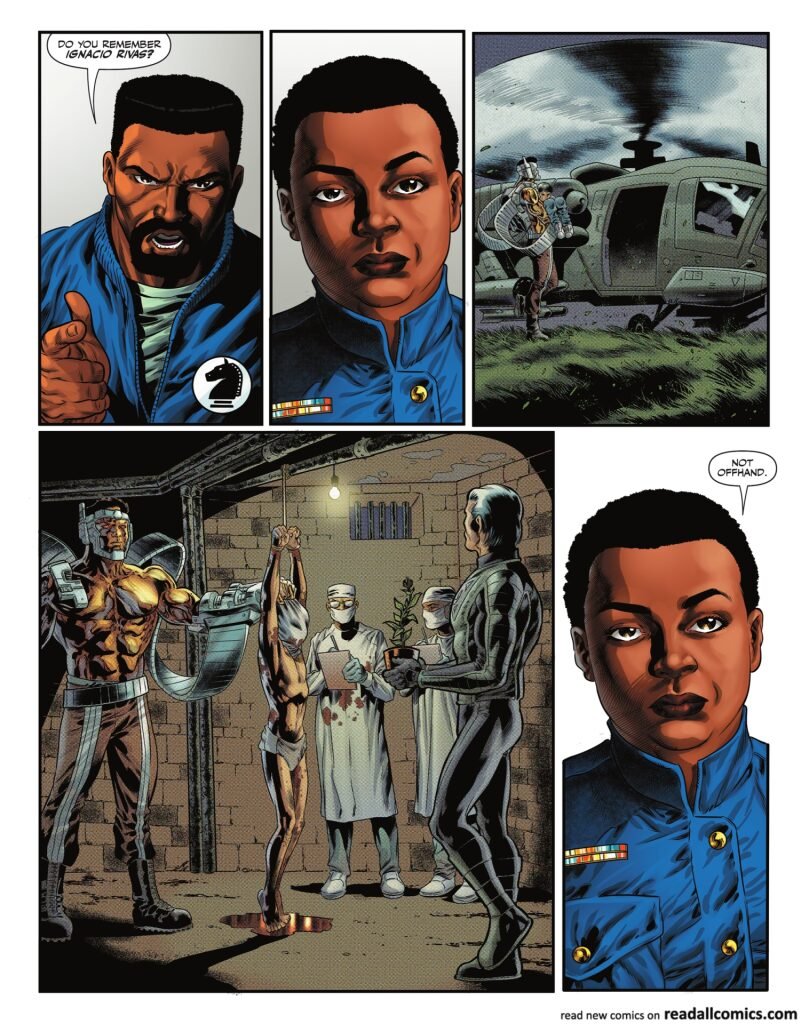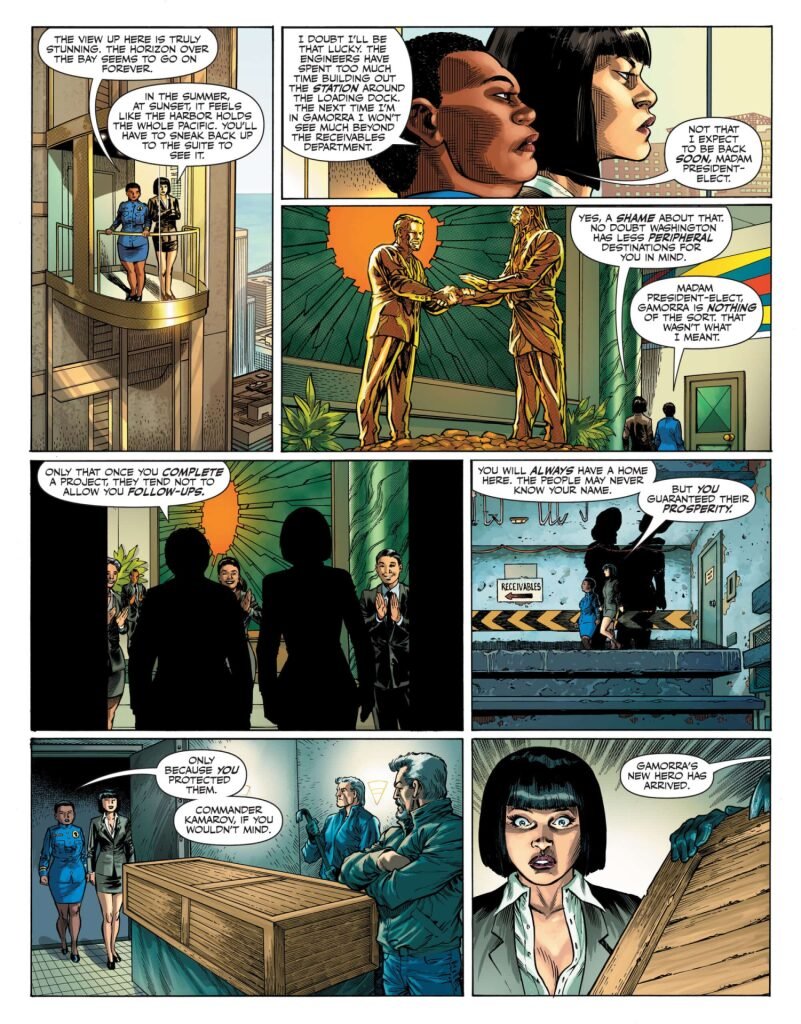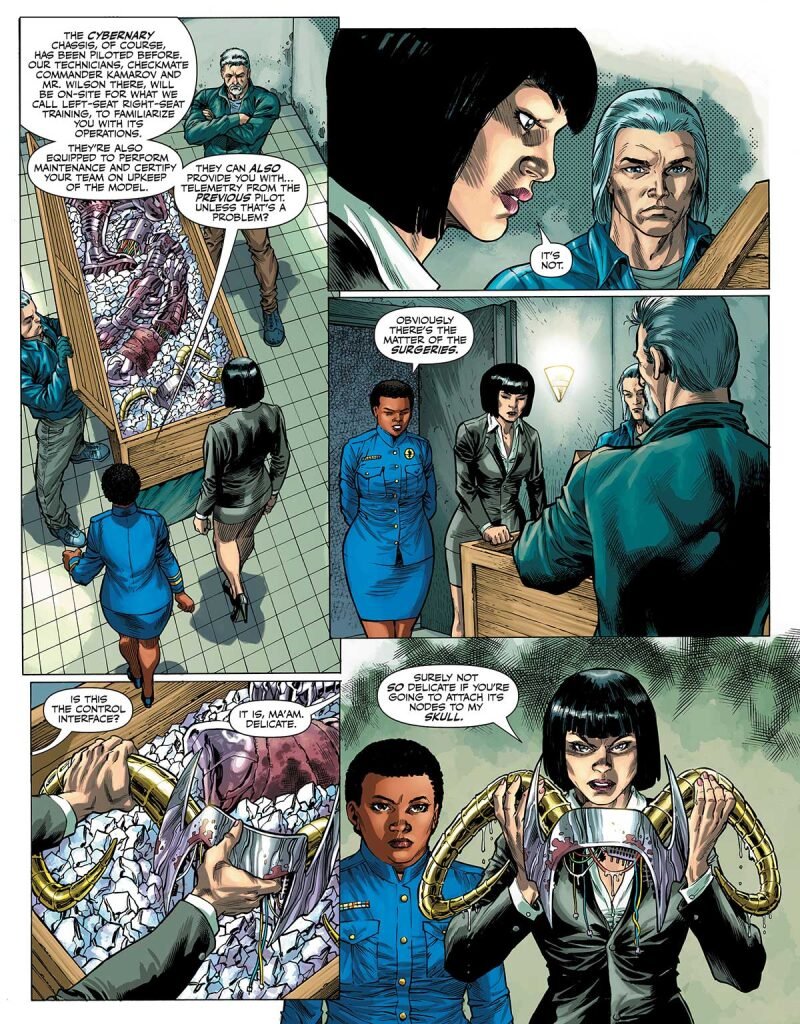Writer: Spencer Ackerman
Artists: Even Narcisse, Jesus Merino, Jorge Fornes
DC Comics (Black Label imprint), June 2023
Such high hopes we had for this title.
Here is the promotional copy:
The island nation of Gamorra is eager for American investment—and even more eager for American metahuman weapons. Amanda Waller has just what they want: the Cybernary system. But the blood that her mercenaries spilled to get it has put her directly in Jackson King’s sights—so now he’s in the sights of the deadly Deathstroke!
Purchasers of superhero comics published by one of the two big American comic book companies walk with mud-filled boots. We know that nostalgia does not equal quality. And we know that DC Comics and Marvel Comics are so enamoured of their superhero catalogue, they cannot seem to look beyond them. Yet we plod through the mud anyway.
The “Waller” of the title is Amanda Waller, a character we much respect – see for example https://worldcomicbookreview.com/2017/12/06/happy-thirtieth-birthday-amanda-waller/ . Amanda Waller is an arch-manipulator and perfectly suited to an espionage title.
As to “Wildstorm”, this is a reference to a portfolio of characters sold by creator Jim Lee to DC Comics in 2000. Mr Lee rose to fame during the 1990s, when superhero characters notoriously took on a militaristic and cyborg-y bent. Some were peacekeepers of sorts: superheroes who were charged by government or by shadowy world government officials to protect the world. Some formed the foundation of some wonderful titles, such as The Sleeper and The Authority. Some of those characters were integrated into the DC Comics’ mainstream panoply, notably Midnighter from The Authority.
Others quietly, appropriately faded away. These dated creations can only be found catalogued in oddball online superhero directories. The discount bins at comic shops were emptied of them a very long time ago. Mr Lee, who has for over 20 years been DC Comics’ frontman, probably forgot most of them.

On nostalgia: We had hopes that the title would be in the same vein as John Ostrander’s fun and thrilling escapade, The Janus Directive. Perhaps most notable about this series from 1989 is, akin to the two faced Roman god Janus, it is at once enthralling and yet completely overlooked. It goes too far to say the story was as complex as a Swiss watch, but to readers of superhero comics it was no less beautiful in its precision. The Janus Directive involved the spymasters of DC Comics’ Checkmate ensemble; the shanghaied supervillain team Suicide Squad; the nuclear-powered superhero Firestorm; the time-lost airforce hero Captain Atom and his despicable adversary Major Force; the patriotic Force of July; a mercenary called Manhunter (Mark Shaw, the recent villain of the latest Checkmate! series). It spins and revolves like seamless brass cogs, and, in time, the villain is revealed. Setting the protagonists against each other is the ever-calculating Kobra and his worshipping cult followers. The Force of July have been decimated, and Checkmate humbled. Even Amanda Waller falls victim to Kobra’s machinations.
If only Waller vs Wildstorm has a shred of the quality of that story. The cover is wonderful: the art features faux creases in the cover corners as if the comic was a well-thumbed 1980s Robert Ludlum novel plumbing the nasty glamour of the Cold War. But this is merely mud glistening.
A significant of the problem is that the reader is understood by the creative team to recognise the recycled Wildstorm elements within the story. Many of these are more than just faded away – they are completely obscure. The President-elect of the island-nation of Gamora (a fantasy twin of Singapore, created by Warren Ellis for Wildstorm Comics in the 1990s) is gifted a Cybernary suit by the US government. “A what?” you might ask, and fair enough. Cybernary was an under-dressed cybernetic character from Wildstorm Comics, created in 1995, and the subject of two failed miniseries (1996 and 2001). It must have taken a shovel, a pick axe and a spotlight to have dredged this concept up from the muck. Similarly, Deathtrap and the MERCs have not seen the light of day in decades.
As Easter eggs go, they are very stale. There is no reasonable parallel to, say, when in 2002 Kurt Busiek revived the legendary character Paul Kirk for The Power Company (see https://worldcomicbookreview.com/2022/08/03/happy-20th-birthday-the-power-company-and-a-nostalgic-look-at-the-long-lost-dcmbs/ ) or when Jason Todd was dragged from the grave in 2005.


The issue is riddled with these characters. A little further along, and the main protagonist Jackson King has been abruptly captured by Amanda Waller. King is quickly rescued from captivity by his old colleagues from StormWatch. As with the MERCs, we have not seen some of these characters for a very long time. Crashing through the fuselage of the aircraft carrying Jackson King is Fuji. The last notable appearance of Fuji was in Alan Moore’s WildCATS in when the character’s mind was folded into origami by the villainous Tao. That was back in in 1998.
We wonder whether the creators of this title believed that the appearance of such characters would bring delight to fervent readers of 1990s Wildstorm Comics. But we assume most of those people are now paying mortgages and talking to their friends on Facebook about the antics of their teenage kids, and that they are not reading this.
All of this criticism is barely whispered, of course, if the story holds up. After all, Warren Ellis was able to successfully fuse many of exactly the same character elements for his The Wildstorm series in 2017 – see https://worldcomicbookreview.com/2017/11/16/the-wildstorm-2-8-review/ . The Wildstorm was an espionage title of grit, sneakiness, and high stakes: a multi-party confrontation where no one was a good guy or a bad guy. It was brilliantly executed.
But Waller vs Wildstorm is instead an atrociously weak story. It consists of some incomprehensible nonsense about the betrayal of the United States by arming Gamora with the Cybernary armour, with plot twists as bewildering as a five year old’s “knock knock” jokes. Try to follow this. King has Waller arrested: they talk at length and the MERCs arrive to take Waller away. And then, within the space of six pages, Waller turns the MERCs to her side using an improbably easily found video of King killing a man: King is subdued and put on a plane: the plane is destroyed and King is saved by Stormwatch. You can see what writer Spencer Ackerman is trying to do – create a suspenseful pendulum as King’s and Walker’s fortunes wax and wane against the other. But Mr Ackerman does this with an absence of finesse. It is rushed and jarring.
The story uses the old characters as a worm-ridden keel, not as adornment. And given the characters are forgotten by almost everyone, the entire artifice slowly settles in, shudders, and lists.

